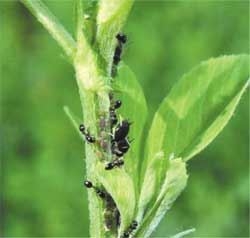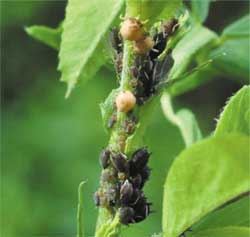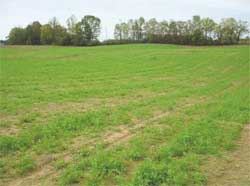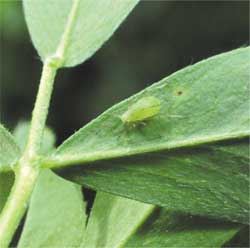Black Legume Aphid In Alfalfa: Watch Fall-Seeded Fields Closely
DR. LEE TOWNSEND
LEXINGTON, KY.
The black legume aphid (or cowpea aphid) is an unfamiliar sight in Kentucky alfalfa; however, there were many established colonies on alfalfa in Fayette County late last week. Adults have shiny black bodies; nymphs are slate gray. The legs are white with black tips. Saliva injected as this aphid feeds can stunt or kill plants. In addition, it excretes lots of honeydew; consequently, extensive buildups of sooty mold are possible. Ants protect aphids from natural enemies as they tend the aphids to collect honeydew (Figure 1). Sooty mold build-up can affect plant productivity and make alfalfa unpalatable to livestock.

Figure 1. Black legume aphid adults
and nymphs tended by ants.

Figure 2. Bloated straw-colored aphids have been
attacked by tiny wasps, effective natural control agents.

Figure 3. Scattered infestations of black legume aphids
in 2008 caused some bare spots in fall-seeded fields.

Figure 4. Light green pea aphids are
common on alfalfa in the fall and spring.
Aphids are cool season insects so infestations begin in the fall and can continue through to spring. There are no treatment guidelines for the insect. However, seedlings can sustain lower aphid populations than established plants. It will be worthwhile to scout fall-seeded fields for colonies of this aphid on a weekly basis after germination.
The light green pea aphid is commonly found in Kentucky alfalfa during the fall and spring but this aphid rarely produces any visible symptoms or plant stress.
Management
Insecticide recommendations for controlling aphids in alfalfa are available in the UK Cooperative Extension publication, Insecticide Recommendations For Alfalfa, Clover, and Pastures – 2014 (ENT-17). ∆
DR. LEE TOWNSEND: Extension Entomologist, University of Kentucky